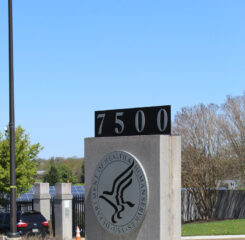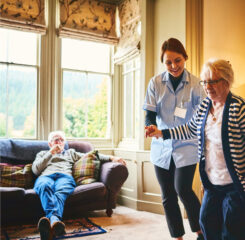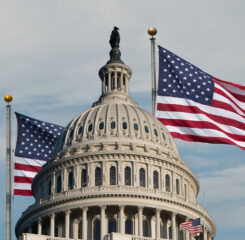Funding for Home and Community-Based Care under the American Rescue Plan
Note: Our article from March 10 provides an updated overview of the American Rescue Plan. Read the update here.
Earlier this week, the House Budget Committee passed the American Rescue Plan Act out of committee and to the full House of Representatives.
This article is meant to describe provisions in the package that could lead to increased funding and/or opportunity for home and community-based care providers. As reference full House bill is linked here.
Funding for Medicaid Home and Community-Based Services
Potentially the most significant item in the American Rescue Plan is dedicated funding for Medicaid home and community-based services (HCBS). Specifically, the Plan provides a one-year increase of 7.35 percentage points in the federal share of spending for Medicaid HCBS waiver services (e.g., adult day services), state plan services including home health and personal care, and the Medicaid share of PACE organization reimbursement. The Congressional Budget Office estimates that this will account for $9.3 billion of federal dollars to Medicaid HCBS, which has not previously received dedicated federal dollars in COVID-19 relief.
The money would go to state agencies, who would then have discretion over how to use the dollars. Critically, however, the Plan requires that states actually use these dollars for their HCBS programs and not for other purposes. The bill also requires states to implement at least one of sixteen options in their HCBS programs, including but not limited to provider rate increases, paid leave and/or hazard pay for workers, and supporting family caregivers.
The bill also incentives non-expansion states to expand their Medicaid programs by offering a two year, five point increase in the federal share of Medicaid across all services, including the HCBS programs mentioned above. While states would have much more leeway with how to use these dollars, it could provide an important cash infusion that could ultimately support home and community-based care and/or stave off budget cuts.
Older Americans Act COVID-19 Vaccine and Activity Funding
As has been in the case in previous COVID-19 legislation, Older Americans Act (OAA) programs would receive emergency funding under the American Rescue Plan. About half of the proposed $1.4 billion would go to senior nutrition programs, and about a half billion dollar would go to supportive services, which can include HCBS. States can also use the half billion dollar allocation for COVID-19 vaccine outreach, education and transportation specific to older adults as well as activities to mitigate the virus itself and its implications for older people, including social isolation.
While many LeadingAge members do not directly receive OAA dollars, this round of funding may be an important resource toward getting the people our members serve connected to vaccines and ultimately connected back to the community.
State and Local Aid
The American Rescue Plan also includes $350 billion for state and local (city and county) governments. These dollars are separate from and in addition to the CARES Act state and local dollars. The American Rescue Plan offers states and localities more flexibility with how to use the dollars relative to the CARES Act money, and HCBS providers may be able to receive additional relief from this appropriation if the American Rescue Plan becomes law.
Many states created HCBS-specific and/or broader long-term care relief funds using the CARES Act dollars. While there is no requirement that states/localities do so with any of the COVID-19 relief dollars they received or would under this bill, these dollars may be an avenue through which HCBS providers are able to access direct financial support.
Paycheck Protection Program
The Paycheck Protection Program (PPP) emerged as an important lifeline for many HCBS providers otherwise not able to receive financial support during the pandemic. While the December relief bill created a second draw loan program and added $284 billion to the PPP fund, the American Rescue Plan makes some additional changes to the program that could expand eligibility to some HCBS providers.
Under current PPP rules, most organizations must employ 500 workers or fewer to be eligible, regardless of how many locations they operate. The American Rescue Plan would shift this policy for not-for-profit organizations and allow larger not-for-profit organizations to receive a PPP loan if they have 500 workers or fewer in each physical location they operate.
So for example, a not-for-profit multisite aging services organization that has a nursing home with 300 workers, an adult day services program with 20 workers and a home health agency with 350 workers currently cannot get a PPP loan because it has 670 workers. Under the American Rescue Plan, however, it would be eligible because each of its locations has fewer workers than the limit of 500.
This provision could open the doors to HCBS providers that exist within larger organizations and health systems. First draw PPP loans are based on 2.5x an organization’s monthly payroll, limited to $10 million.
Additional Provisions
The American Rescue Plan is a far-reaching legislative vehicle crossing twelve committee jurisdictions. LeadingAge compiled summaries of relevant committee bills, linked below for reference.
- Energy and Commerce: Money for vaccines, testing and PPE; public health workforce funding; Medicaid funding (including Medicaid HCBS)
- Ways and Means: Stimulus checks of up to $1,400; funding for unemployment insurance; Elder Justice Act funding.
- Education and Labor: Federal minimum wage increase ($15/hour by 2024); Older Americans Act funding, including special money for COVID-19 vaccine education and access, and for services to address social isolation among older adults as a result of the pandemic; OSHA/worker protection funding.
What’s Next?
The House is scheduled to vote on the bill before the end of the month. The Senate is working on its own bill in real time. While the Senate bill is expected to hew closely to the House, there may be revisions with notable implications for HCBS providers. We continue to work closely with our members and with Congress to ensure that the needs of HCBS providers and other aging services organizations have a seat at the table as the next relief package takes shape.
Members may reach out to Brendan Flinn (bflinn@leadingage.org) with questions, and are encouraged to visit our 100 Days of Advocacy page for additional information on how to engage in the process.

Most Recommended
October 15, 2025
 Shutdown Week Three: Impact of Ongoing Closure on Affordable Housing
Shutdown Week Three: Impact of Ongoing Closure on Affordable Housing
December 10, 2025
Fiscal Year (FY) Funding 2026
October 07, 2025
Immigrant Workforce Matching Program Brings Workforce Relief
Recently Added
December 23, 2025
 CMS Debuts Models: ACCESS, ELEVATE and LEAD
CMS Debuts Models: ACCESS, ELEVATE and LEAD
December 22, 2025
GAO Report: Ensuring Accessible Healthcare
December 19, 2025
House Moves Forward on Affordable Housing Reforms
December 19, 2025



